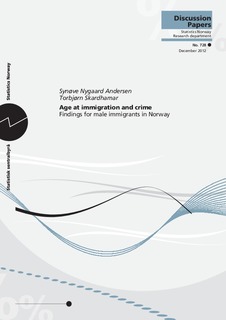| dc.contributor.author | Andersen, Synøve Nygaard | |
| dc.contributor.author | Skarðhamar, Torbjørn | |
| dc.coverage.spatial | Norway | nb_NO |
| dc.date.accessioned | 2019-11-13T07:23:25Z | |
| dc.date.available | 2019-11-13T07:23:25Z | |
| dc.date.issued | 2012-12 | |
| dc.identifier.issn | 1892-753X | |
| dc.identifier.uri | http://hdl.handle.net/11250/2628015 | |
| dc.description.abstract | Previous studies have identified an “immigrant paradox” in crime in which crime rates are highest among immigrants who are young when they arrive in the host country, even though social capital and integration in the labour market and social networks favour the young. We use Norwegian registry data to estimate the probability of committing at least one crime in any year after the year of immigration, and we include interaction terms between age and age at immigration to explore the troublesome temporal association between age, age at immigration and duration of residence. The results suggest an overall negative association between age at immigration and registered crime, which seems to be exaggerated by the residual effect of the omitted duration of residence variable. Comparability of results between studies depends crucially on how age at immigration is measured. | nb_NO |
| dc.language.iso | eng | nb_NO |
| dc.publisher | Statistisk sentralbyrå | nb_NO |
| dc.relation.ispartofseries | Discussion papers;728 | |
| dc.subject | Innvandring | nb_NO |
| dc.subject | Kriminalitet | nb_NO |
| dc.title | Age at immigration and crime. Findings for male immigrants in Norway | nb_NO |
| dc.type | Working paper | nb_NO |
| dc.description.version | publishedVersion | nb_NO |
| dc.subject.nsi | VDP::Matematikk og Naturvitenskap: 400::Matematikk: 410::Statistikk: 412 | nb_NO |
